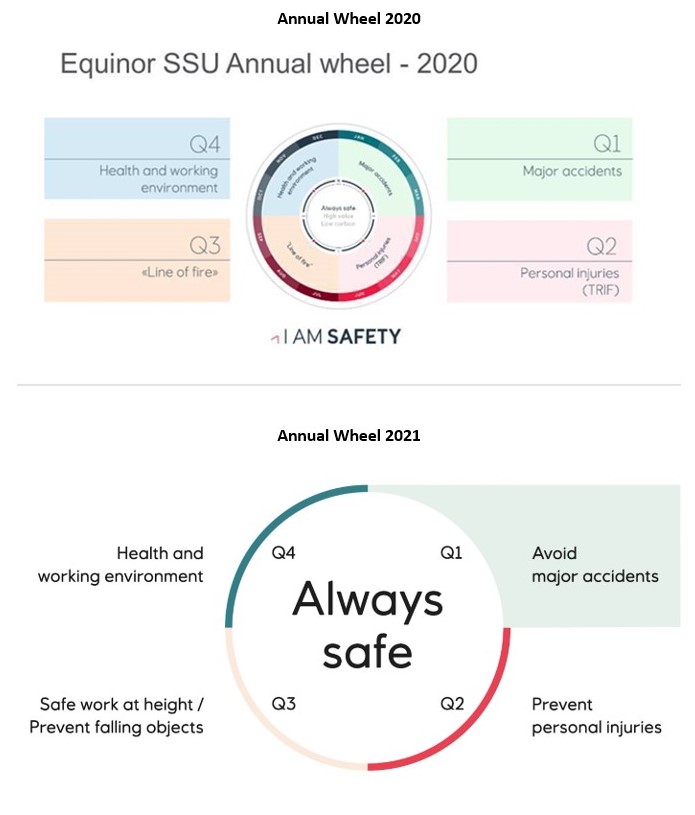The initiative “Always safe”, a result of the collaboration between AkerBP, Vår Energi and Equinor, was established in 2020, with the aim to strengthen the industry’s safety culture, work together towards zero major accidents, and avoid injuries and undesirable incidents in the daily work.
Each year, the “Annual wheel” is released and defines priority topics and associated actions to ensure a stronger common focus on main challenges, along with relevant learning packages available at the beginning of every quarter.

The learning package of Q3 2021 was focused on observation of hazards, especially on falling objects, with the goal to prevent dangerous conditions and incidents by:
- Practicing the correct use of observation techniques and learning from each other
- Increasing the number of reported observations and learning from them
- Strengthening the culture for registration and follow-up of observations
In total, answers from more than 2,700 teams and leaders were registered to the reflection questions in the case studies in the learning package for Q3 2021. An analysis per question on the case “Observation in the field” completed by the operative personnel is presented.
Challenges/obstacles for observation and reporting
The participants were asked what the biggest challenges/obstacles they experience are, in terms of observing and reporting dangerous conditions. The 6 main categories which together make up 74% of the team responses are as follows:

#1 Normalization of risk
Becoming blind to one’s surroundings in routine jobs and familiar work areas can happen without even noticing. Dangerous conditions can be perceived as normal over time and accepted practice and silent deviations may arise.
#2 Lack of competence or experience
Having competence in observation technique is crucial. One has to know what to look for and how to report it, as well as to know the requirements and procedures and tools/equipment that are used. Being new in the job or working in new areas is also a factor in ineffective reporting.
#3 Lack of feedback and follow-up
What happens after someone reports dangerous conditions should not be dismissed. The lack of feedback and follow-up of reported observations can reduce the motivation to observe and report.
#4 Time and work pressure
Taking the time to observe / report in a busy workday can be very challenging. Some may also experience ‘operations before safety’ thinking, which is counterproductive in terms of avoiding injuries.
#5 Fear of consequences
Reporting can be met with negative reactions or lead to negative consequences for the person(s) concerned. It can give one self or others extra work and the process can be experienced as comprehensive.
#6 Lack of focus
It can be very difficult to observe dangerous conditions if one is not completely aware. Most often, the focus will be on the work task at hand, while unconsciously ignoring what is happening in the background.
Solutions for challenges/obstacles
The next question participants were asked is how these challenges/obstacles can be best solved. The 6 main categories which together make up 66% of the team responses are as follows:

#1 Open and safe culture
Having an open and trusting safety culture, where there is room for discussions and questions, is of utmost importance. When there is a positive attitude towards safety, one feels safe to report observations.
#2 Increased focus
In order to have increased attention / focus on observation, one should be aware and look for possible dangers in the surroundings. Using all senses and the right mindset and attitude are also key elements in reporting dangerous conditions.
#3 Training and practice
Experience transfer, training and practice in what to look for and how, and in the use of reporting tools play a major role in overcoming the challenges mentioned before. Having good knowledge of tools/equipment, demands and procedures can also help towards effective reporting.
#4 Taking the time
Time pressure can be solved with being ahead all the way. This means to actively set aside time through planning and prioritizing, in order to avoid taking shortcuts that may create dangerous conditions.
#5 Good communication and dialogue
Communicating relevant information, such as talking about the challenges together and arranging for dialogue and discussion in the team can help all persons involved to be more aware of the possible dangerous conditions.
#6 Feedback and follow-up
Specific feedback on reported observations and showing what the reporting have helped with (follow-up and actions) can lead to enhanced motivation for observing and reporting.
Expectations from the leader
The last question operative personnel answered was about the expectations they have for their leader when they write an observation. The 4 main categories which together make up 87% of the team responses are as follows:

#1 Give feedback
When reporting an observation, one expects the leaders have to give feedback on whether measures have been implemented, which essentially means an open dialogue culture has been established.
#2 Take action
Observations on dangerous conditions are expected to be followed up by leaders, with taking appropriate measures and experience transfer. It is also very important that improvement measures are made visible by sharing them with the team.
#3 Take the observation seriously
Leaders are expected to take reported observations seriously, to read and assess every observation and to listen to the person reporting. The observation should not be dismissed or trivialized.
#4 Follow up
Taking the observation further in the system and following up the process by leaders are also expected. Leaders should support improvements/observations that are being reported and should push through the management.




























































